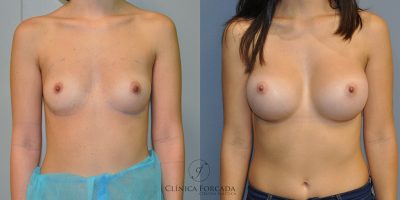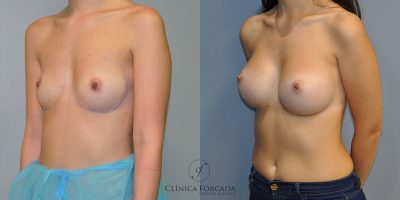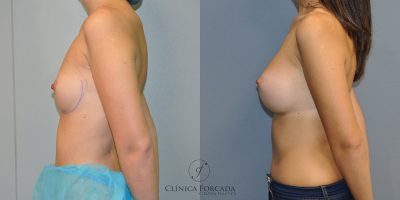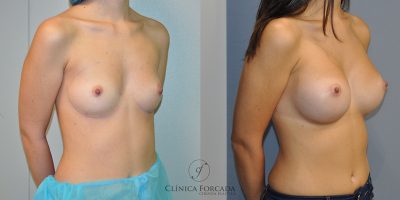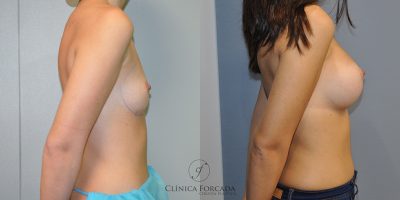Breast augmentation surgery is the most frequently performed cosmetic surgery in Spain with around 20,000 surgeries annually. It is a very safe and painless surgery that has been performed since the 60s. The intervention consists of the implantation of a silicone gel prosthesis in a plane inferior or superior to the pectoral muscle. After more than 50 years of experience with breast prostheses of different types, silicone gel has proven to be the best material for breast augmentation, becoming the standard in our clinical practice. Furthermore, the quality of the prostheses has improved during this time to adapt perfectly to the body, which allows us to speak of a highly safe intervention with a high satisfaction rate. Almost all of our patients are very satisfied with the result and only regret not having had the surgery sooner.
Planning the surgery
The canon of breast beauty is totally subjective, so communication between you and Dr. Forcada is absolutely crucial. In the first consultation, the different treatment possibilities will be assessed with their pros and cons, always putting your short and long-term health before any aesthetic criteria . During this consultation, a thorough physical examination will be carried out in which the current size and shape of your breasts, the firmness of your tissues, the presence of stretch marks, and any slight asymmetry will be noted. In those cases where the breasts are sagging, what we call “breast ptosis”, the possibility of combining a mastopexy (breast lift) or treating only with a prosthesis will be considered.
Types of scar
There are three types of scar, in the armpit, around the areola and in the undermammary fold. Deciding which one is most appropriate for you will depend on your preferences and the characteristics of your fabrics.
Implant placement plane (Submuscular/subfascial-subglandular)
The breast implant can be placed below or above the muscle. In very thin patients we prefer submuscular placement to provide greater coverage to the implant, which reduces complications and gives a more natural appearance. However, there are more complex cases in which we opt for placement above the muscle (subfascial or subglandular) to obtain more natural results. Remember that each case is unique and deserves individualized treatment.
Type of implants
Implants can be round or anatomical. The anatomical implants are all textured and are characterized by having a water drop or teardrop shape and a more cohesive gel, that is, slightly harder. On the other hand, round implants can be smooth or textured and have a less cohesive gel, that is, softer to the touch. In general, our recommendation is the use of smooth round implants in the majority of our patients since they give results that are visually as anatomical as with anatomical ones, without the risk of rotation and without the risks of textured implants (lymphoma). In some cases we choose round textured implants (especially in mastopexy), to give better filling in the upper part of the neckline (rounder effect) and in some other selected cases we choose anatomical implants to round the lower part of the breast more (tuberous breasts). .
Surgery
All our operations are performed in a hospital operating room and under general anesthesia. We consider that for this type of intervention, local anesthesia has more complications and is much more bothersome. The duration of the operation is less than 1 hour , although it can last longer in very specific cases.
Drains?
We do not use postoperative drains since some scientific studies suggest the possibility that it is related to a higher rate of postsurgical infection.
Bandage?
We do not use compressive bandages since they do not serve to prevent post-surgical hematoma and generate more post-operative pain.
Postoperative
The day after the intervention, a tight sports bra is put on. It is recommended not to wet the chest for the first 3 days after surgery. It is important to maintain relative rest for at least 7 days, without exertion of any kind. In general terms, you will be able to lead a practically normal life a week after the operation. Sports can be resumed one month after surgery.
Complications
Breast augmentation, performed meticulously and by a plastic surgeon, is a very safe technique with few complications. As with any operation, there is a risk of hematoma, infection or poor healing, although the risks are generally very low. In the long term, the most common complication is capsular contracture, which consists of the retraction of the capsule that forms around the implant and which may require changing the implant. It is extraordinarily unlikely that prostheses will break. In that case it would also be necessary to replace the prostheses.
